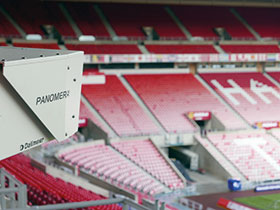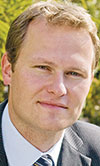

Video technology has become an indispensable element of the security arrangements in sports stadia. With its introduction of the Panomera multifocal sensor system, German developer and manufacturer Dallmeier unveiled a new approach to video surveillance of large areas. This technology offers many advantages for those responsible for stadium security.

Roland Meier, director of Panomera Multifocal Sensor Systems at Dallmeier explains further.
What is so innovative about the Panomera system?
With the Panomera multifocal sensor system, a huge area can be monitored from a single location extremely efficiently. The most impressive aspect of the product is that it combines the overall view with simultaneous top detail resolution. Even more distant objects are displayed with the same resolution as objects in the foreground of the picture.
In principle it is exactly what the user wants from a video surveillance camera. The entire area observed by the camera should be displayed in uniformly high quality. But anyone who has ever zoomed in on an image will notice a marked difference: The further you ‘move to the back’ of the scene, meaning, zoom into the picture, the greater the loss of detail, causing the picture to become blurry. While objects in the foreground are certainly displayed with sufficient resolution, when the user attempts to enlarge objects from the background, they appear as many ill-defined blocks.
Let’s consider an example from real life, such as an image of a large stadium. The faces of people in the front rows are still recognisable, but when the image is enlarged the rows further back become blurred and faces become unrecognisable. This is why, when we developed the Panomera, one of our objectives was to ensure that the resolution never fell below the specified parameters, not even in the most distant areas of the image.
How is this high resolution possible?
We are using a completely new lens and sensor concept. In conventional cameras, the pixels are used uniformly within the sensor, that is to say, the available megapixels are distributed evenly throughout the entire image. But the actual scene is not two-dimensional like the sensor, it is three-dimensional – and the expanse of the lateral and depth perspectives becomes progressively larger the further back you go. Now if the pixels are distributed evenly on the camera sensor, this means that the same number of pixels is available for capturing a much larger background area as is available for the foreground of the image. And logically, as a result, more distant objects cannot be resolved any more when you zoom in.
With Panomera on the other hand, we can guarantee uniform resolution over the entire object space. We do not use just a single optical device, but a multifocal sensor system, meaning several lenses with different focal lengths. In this way, we ‘slice up’ the scene so that each area has the optimum focal length assigned to it.
What advantages does this have for monitoring stadia?
Panomera works well both for very wide panoramas and for areas involving great distances. An entire stadium can be monitored permanently with just two Panomera systems. In effect, it is as if you were to combine the advantages of an overview camera and a high optical zoom PTZ camera: Panomera records the entire area continuously, like an overview camera – unlike a PTZ camera for example, where only the currently active zoom area is recorded. But at the same time you can move and zoom anywhere in the entire coverage area – and individuals are clearly recognisable even at distances of more than 160 metres.
So continuous recording of the entire surveillance area is not standard practice?
Until now, no. Of course, fixed dome or box cameras always record the whole of the area they are monitoring. But these cameras are not equipped with an optical zoom, so they are not suitable for monitoring expansive areas, or at least only as overview cameras. This is why a lot of PTZ cameras are being used at the moment. These can be used to zoom and move within the scenes. But at the same time PTZ cameras have a definite disadvantage: They can only ever record the area that the operator is currently watching live.
Let’s revisit the example of our stadium: If the operator is currently zooming in on the front left portion of the image, only this area is being recorded. So if an incident were to take place at a different location at the same time, it would not be possible to review it afterwards. With Panomera, on the other hand, the entire scene is recorded continuously and in maximum detail resolution – regardless of which area the operator is viewing live. This makes it possible to analyse incidents after they have occurred.
Couldn’t you also achieve this effect by using several HD cameras in conjunction with each other?
An operator can work much more efficiently with a single, synchronised system than he ever could with multiple HD cameras strung together in line. The operator would have to concentrate on lots of individual images simultaneously. Moreover, the field viewing angles could never be synchronised with one another as well as is possible with a single, integrated multifocal sensor system. Quite apart from the fact that the operator would be engaged in a constant ‘battle for resources’ in order to obtain comparable resolution.
Another advantage of the Panomera sensor concept is a substantially higher dynamic range. Panomera works with several sensors, each of which selects its own exposure strategy in order to achieve ideal saturation. While with other cameras an average value is determined, Panomera can make distinctions more effectively: Light areas are exposed for a shorter time and dark areas for a longer time. As a result, situations with a large dynamic range can also be recorded with good quality, without overexposure or ‘drowned’ black areas.
If the entire scene is monitored by just one camera, is it only possible for one security operator to work with the camera or can several operators access it?
In contrast to PTZ cameras, with which only one operator can control the camera, with Panomera, an unlimited number of operators can navigate across the entire scene independently of each other. Although all operators are connected with the same camera, each of the individual users can select his view individually and zoom or pan as he desires. Or he can perform evaluations of the recordings at the same time. So analyses can be carried out by any number of employees at various workstations simultaneously, for example one may be watching the overview image live, another may zoom in on suspicious fans in real time, while yet another is looking at the recording from an hour ago to see how the stadium filled up.
Do you not need enormous bandwidth for this?
Owing to the multicast capability, several users can view the images from Panomera without requiring repeated transmission of the data via network. This reduces the necessary bandwidth significantly.
For more information contact Dallmeier Southern Africa Office, +27 (0)11 510 0505, dallmeiersa@dallmeier.com, www.dallmeier.com
| Tel: | +49 941 870 0111 |
| Email: | dallmeiersa@dallmeier.com |
| www: | www.dallmeier.com |
| Articles: | More information and articles about Dallmeier Electronic Southern Africa |

© Technews Publishing (Pty) Ltd. | All Rights Reserved.